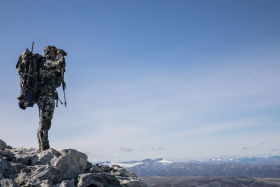Spanish hunter Pedro Ampuero spent a week in the wild and unspoiled nature of the Norwegian mountains hunting caribou. We asked him a few questions about this very special hunting adventure.
WHAT ARE THE MENTAL AND PHYSICAL DEMANDS OF A CARIBOU HUNT?
PEDRO: Tracking caribou herds involves covering many miles, day after day, with huge altitude differences. You need above-average physical fitness and it is vital that you train with your equipment beforehand. The sheer weight of your backpack can be the biggest challenge. During the season, you have to expect all kinds of weather. Cold, rainy days are not uncommon. Mental strength plays a key role in long hunts. You have to learn to cope with being miserable, tired, and hungry and generally be prepared to live outside your comfort zone. The more you enjoy the whole experience, the more success you will have.
WHAT DO YOU EXPECT FROM YOUR EQUIPMENT?
PEDRO: It is important to have a backpack with a strong frame that distributes the weight to the hips. High-quality optical equipment, including powerful binoculars, is vital. The more you can see through them, the less distance you have to cover on foot.
WHY DO YOU HUNT CARIBOU?
PEDRO: Because backpacking through remote mountainous regions is one of my favorite kinds of hunting. There are very few places in Europe where you can escape from civilization for a whole week. There is something special about only taking what fits in your backpack. You go to places that you can only get to on foot and sleep wherever you want. It is the ultimate sense of freedom. You are totally responsible for your own actions, but you also have to accept the consequences.
WHICH MEMORY OF THIS HUNT STANDS OUT FOR YOU?
PEDRO: The time when, out of nowhere, a herd came over a ridge and charged toward us. My companions and I immediately knew which bull it was going to be, there was no doubt about it. After I fired the shot, it took us a minute to realize what had just happened. We all felt like we were dreaming, but then reality came back to bite us. I will never forget the pain of our walk back. We had suffered hardships and setbacks for a week, but a brutal six-hour hike with 63 kilos (139 lbs) on your back is – for me – the best way to finish.

Caribou
The caribou (Rangifer tarandus) – in some parts of the world also referred to as reindeer – is found from northern Greenland to the 48th parallel in Asia and America. Its home is the barren expanses of the Arctic tun-dra and taiga. Traditionally, a distinction is made between the medium-sized tundra cari-bou and the large, darker forest caribou, and there are ten different sub-species. Tundra caribou migrate up to 5,000 kilometers (3,100 miles) every year in herds of several hundred animals, while for-est caribou roam the boreal forests in small groups.
The worldwide population of wild caribou is estimated at about 2.9 million, of which 1.9 million live in North America and one million in Eurasia. However, the huge herds that roam the vast landscapes of Lapland are domesticated animals traditionally kept by the indigenous Sami people The number of caribou in neighboring Norway is estimated at 250,000. Experts believe winter stocks of wild caribou (Rangifer tarandus taran-dus) number around 25,000.
Caribou
Caribou are the only deer species whose females also grow antlers. They need to find adequate food in winter and spring in order to fatten up, so they have to defend their sparse feeding grounds against other females. They shed their antlers once their calf is born in spring. Even young caribou begin growing antlers from the age of 12 months. Bulls shed them after the rut in mid-October.
Caribou
In the winter months, cari-bou feed mainly on lichens on the ground and trees. In summer their food consists of herbs, grass, dwarf bushes, and mushrooms. Germinating green plants are a vital source of protein. The animals seek them out in spring when the snow starts to melt, but if there are none to be found they will also eat bird’s eggs and small rodents.
Caribou
LENGTH: 185–220 cm/73–87 in (males), 170–195 cm/67–77 in (females)
SHOULDER HEIGHT: 90–135 cm/35–53 in (males), 70–100 cm/26–39 in (females)
WEIGHT: 210–270 kg/463–595 lbs (males), up to 140 kg/309 lbs (females)
LIFE EXPECTANCY: 15–18 years
SEXUAL MATURITY: 18 months
NATURAL PREDATORS: Wolf, lynx, wolverine (adult animals); brown bear, Golden Eagle, White-tailed Eagle, Raven (calves)
MATING SEASON: Mid-September to mid-October
FAWNING SEASON: May to June

About
Pedro Ampuero
Pedro Ampuero vive y respira la caza. Sus aventuras de caza le han llevado a algunos de los rincones más remotos del mundo, pero su tierra natal, el País Vasco español, siempre está en su corazón. Creció rodeado de ovejas, rifles de caza, perros y libros de caza, y fue a su primer viaje de caza con su padre cuando tenía sólo cinco años. En pocas palabras, para la familia Ampuero la caza forma parte de la vida. Lo que más le gusta es la sensación de libertad que experimenta cuando está en la naturaleza. A Pedro le encanta el reto de confrontar los elementos poderosos de la naturaleza. En las montañas es donde descubre su verdadero ser.
SI QUIERES SABER POR QUÉ FUE UNA LUCHA INCLUSO PARA ENCONTRAR AGUA DURANTE LA EXPEDICIÓN A NORUEGA, VISITA EL BLOG DE PEDRO
© photos by SlotsMedia





















